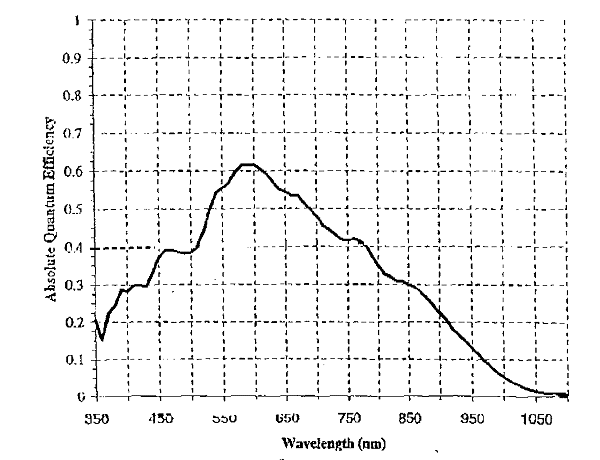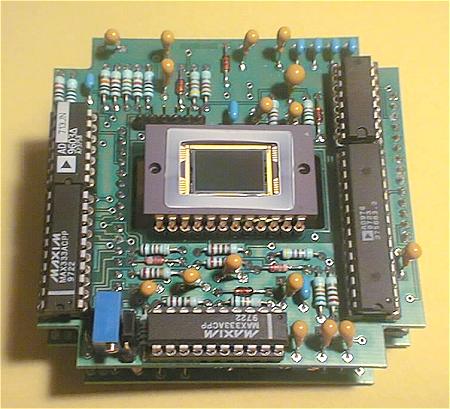
Kodak KAF-0400 CCD quantum efficiency.

The KAF-1600 is pin-to-pin compatible with the KAF-0400 ant its sensitive area is four times larger than that of the KAF-400. It has 1768x1024 pixels; it is also more expensive. The price of a grade 2 KAF-1600 was about US$5800 (35000 FF) but special offers may be available. If the cost doesn't appal you, it is technically possible to replace the KAF-0400 of AUDINE with a KAF-1600, even if the external aspect of the CCD component is rather different. To implement a KAF-1600, you have to solder U7 and U8 ICs directly on the upper board without using a circuit support.
The KAF-0400L is functionally identical to the KAF-0400 but with an anti-blooming system. For example, it can be used to avoid having ungraceful trails around saturated stars. However, this CCD is not a very good choice for astronomy because it has an efficiency about 30% lower than the standard KAF-0400. In addition, the anti-blooming device located between the pixels may cause some problems for applications needing accurate photometry or astrometry measurements. As a positive point, the area of the pixel covered by the anti-blooming device doesn't generate dark current. In fact, an anti-blooming KAF-0400L CCD has a dark current about 30% lower than the standard KAF-0400.

There is also a colour version : the KAF-0400C. The case of this CCD is smaller than that of the KAF-0400, thus an intermediary printed board is necessary to solder the CCD and to ensure connection to the AUDINE upper board. Once done, the KAF-0400C is fully electronically compatible with the KAF-0400. Other than the case, the only difference is the presence of red, green and bleu filters sequentially covering the pixels in the KAF-0400C.

 |
 |
 |


Kodak can provide a specific version of KAF-0400 with an increased sensitivity in the blue part of the spectrum : the KAF-0401E. This CCD is very different to another CCD produced in 1996, the KAF-0400E. The performances of the KAF-0400E were not very good. Among other things, the dark current was 4 or 5 times higher thanthat of the KAF-0400, the dynamic range was very small, the offset signal varied with temperature and the sensitivity gain at blue was rather modest : 20%... In short, it was not an interesting CCD. Very recently (spring 1999), Kodak announced a new series of CCD with high quantum efficiency at blue wavelengths, the Blue Plus Image Sensor, of which one is the KAF-0401E.The first results show that now Kodak fully masters the technology with high blue sensitivity. To achieve this result, Kodak has made transparent one of the two electrodes used in the two-phase transfer mode of the KAF family of CCDs. This transparent electrode employs ITO technology (ITO stands for Indium Tin Oxide). In addition to the transparency, the electrode has a refraction index such that the reflection losses due to this electrode are very low. The result is that the quantum efficiency at 600 nm wavelength increases from about 38% for a standard KAF-0400 to 62% for the new KAF-0401E. And, the quantum efficiency of KAF-0400E at 400 nm wavelength (30%) is 10 times higher than the one of KAF-0400. At 350 nm wavelength, that is to say at UV, the sensitivity of the KAF-0401E is still 15% ! This CCD even remains sensitive at 300 nm, but at this wavelength, the atmosphere and the optical glasses start to severely attenuate the signal. The dark current, already especially low for the KAF-0400 : 10pA/cm², decreases even more for the KAF-0401E: 6pA/cm2. All that together means a significant sensitivity improvement : the overall sensitivity of KAF-0401E for an image without filtering is about twice that of KAF-0400. Making colour images by trichromy becomes a pleasure with this new CCD, the increased sensitivity at blue wavelengths opens interesting perspectives for spectrography, photometry, high resolution imaging, etc...

KAF-0401E is pin-to-pin compatible with KAF-0400. However some voltages must be adjusted, only by a small amount, for this new component. To use it, you must tune the potentiometers to adjust the amplitude of the clock signals and change the Zener diodes foreseen for KAF-0400 by slightly different voltage Zener diodes. But it is possible and even easy to implement a powerful KAF-0401E within an AUDINE camera.

The table here below summarises the electrical differences between the
KAF-0400 and the KAF-0401E :
|
|
|
|
|
|
|
|
|
|
|
|
|
|
|
|
|
|
|
|
|
|
|
|
|
|
|
|
If you want to use the KAK-0401E, rather than the KAF-0400, you must perform the following adaptations on the AUDINE electronic boards :
When tuning the voltages, the P2 potentiometer has to be adjusted to have -9.0V as the low level of V1 (instead of -8.0V). The high level of this clock remains at +0.5V.
The cost of a grade 2 KAF-0401E is about US$170 (1000 FF) higher than that of a grade 2 KAF-0400, (now called KAF-0401). As the full Kodak series will be replaced by E series soon, the prices should go down. With performances going up, this new series is a very good news because it ensures a long life for our preferred KAF-0400 family
The following image shows the size of a KAF-0400 (or a KAF-0401E) with respect to its big brother a KAF-1602E. As for KAF-0401E, this big CCD has an improved sensitivity with respect to its predecessor, the KAF-1600. The KAF-1602E has 1536x1024 pixels; its sensitive area is four times larger than that of the KAF-0400.

Note : it is possible to implement a KAF-1600 or a KAF-1602E within an AUDINE camera ! For 2x2 binning, the dead time is about 17 seconds,which is not so bad for so many pixels.

The translation in French of the KAF-400 data sheet may be found at
David
Romeuf.'s WEB site.
|
|
|
|